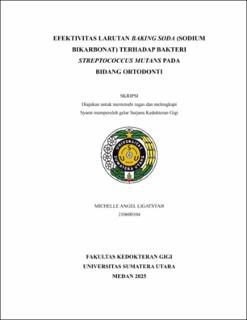| dc.description.abstract | Orthodontic appliances impact the oral cavity's ecology, leading to an increase in Streptococcus mutans levels in saliva. Fixed orthodontic appliance components, such as brackets, bands, and archwires, serve as ideal retention sites for plaque accumulation and bacterial growth. This study is a pure laboratory experimental research with a post-test control group design. The aim of this study was to determine the effectiveness of concentration 70%, 75%, and 80% baking soda solution against Streptococcus mutans. The research samples consisted of cultured Streptococcus mutans ATCC® 25175™, which were diluted and exposed to paper discs impregnated with 70%, 75%, and 80% baking soda, 0.2% chlorhexidine, and DMSO. The inhibition zone measured with caliper, and bacteria percentage reduction assessed with colony counter. The results showed that the highest mean inhibition zone and percentage reduction were observed in the 80% baking soda group. ANOVA test results indicated significant differences in inhibition zones between the 70% and 80%, 70% and positive control, 70% and negative control, 75% and 80%, 75% and positive control, 75% and negative control, 80% and positive control, 80% and negative control, as well as between the positive and negative controls. There were also significant differences in percentage reduction between the 70% and negative control groups, 75% and negative control, 80% and negative control, and between the positive and negative controls. In conclusion, there were significant differences in inhibition zones mean and percentage reduction among the treatment and control groups. | en_US |


